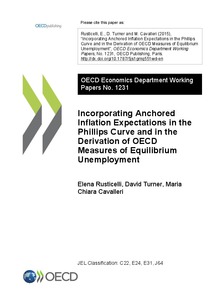Incorporating anchored inflation expectations in the Phillips Curve and in the derivation of OECD measures of equilibrium unemployment
"Inflation has become much less sensitive to movements in unemployment in recent decades. A common explanation for this change is that inflation expectations have become better anchored as a consequence of credible inflation targeting by central banks. In order to evaluate this hypothesis, the...
| Main Authors: | , , |
|---|---|
| Institution: | ETUI-European Trade Union Institute |
| Format: | TEXT |
| Language: | English |
| Published: |
Paris
2015
OECD |
| Subjects: | |
| Online Access: | https://www.labourline.org/KENTIKA-19112618124919308909-incorporating-anchored-inflati.htm |
| Summary: | "Inflation has become much less sensitive to movements in unemployment in recent decades. A common explanation for this change is that inflation expectations have become better anchored as a consequence of credible inflation targeting by central banks. In order to evaluate this hypothesis, the paper compares two competing empirical specifications across all OECD economies, where competing specifications correspond to the ‘former’ and ‘new’ specification for deriving measures of the unemployment gap which underlie the OECD’s Economic Outlook projections. The former OECD specification can be characterised as a traditional ‘backward-looking’ Phillips curve, where current inflation is partly explained by an autoregressive distributed lag process of past inflation representing both inertia and inflation expectations formed on the basis of recent inflation outcomes. Conversely, the new approach adjusts this specification to incorporate the notion that inflation expectations are anchored around the central bank’s inflation objective. The main finding of the paper is that the latter approach systematically out-performs the former for an overwhelming majority of OECD countries over a recent sample period. Relative to the backward-looking specification, the anchored expectations approach also tends to imply larger unemployment gaps for those countries for which actual unemployment has increased the most. Moreover, the anchored expectations Phillips curve reduces real-time revisions to the unemployment gap, although these still remain uncomfortably large, in the case of countries where there have been large changes in unemployment." |
|---|---|
| Physical Description: | 36 p. Digital |

